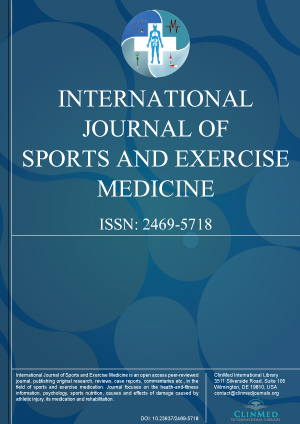Open Access DOI:10.23937/2469-5718/1510215
Effects of a Cognitive Distraction Task on Gait Mechanics in Recently Gait-Retrained Runners
Erin E. Futrell, PT, MPT, OCS, Darcy S. Reisman, PT, PhD, David R Mullineaux, PhD and Irene S. Davis, PT, PhD
Article Type: Research Article | First Published: February 26, 2022
When assessing running mechanics in a laboratory setting, there is risk for performance bias by the participants. The purpose of this study was to determine if runners who had recently undergone gait retraining altered their running mechanics while performing a cognitive distraction task. Two groups of runners were analyzed at 3 postintervention time-points for changes in vertical loadrates, cadence, and footstrike pattern. Runners who received cadence retraining (CAD) did not alter cadence, but...
Open Access DOI:10.23937/2469-5718/1510214
Speed Marching in Military Boots: The Walk-To-Run Transition Speed and Vertical Ground Reaction Forces
LTC Wes O. Zimmermann, MD, PhD and MAJ Eric M. Lever, MD
Article Type: Research Article | First Published: January 24, 2022
Speed marching is the term for moving on foot, in which service members alternate marching and running to cover a certain distance in limited time. The standard load for speed marching is 25 kilograms, this includes a backpack, a tactical vest and rifle. When increasing walking speed, a person will switch from walking to running at a certain speed, this is called walk-to-run transition. The walkto- run transition speed for marching in military boots, with or without a rifle, is unknown. Marching...
Open Access DOI:10.23937/2469-5718/1510212
Pattern of Musculoskeletal Injuries Amongst Male Amateur Basketball Players in Anambra State, Nigeria
Christian Arinze Okonkwo, MSc, Eustus Chigemezu Okereke, B.MR, Joseph Onuwa Umunnah, Ph.D., Peter Olanrewaju Ibikunle, Ph.D., Victor Egwuonwu, Ph.D., Stanley Maduagwu, Ph.D., Kenneth Umezurike Ani, MSc, Dickson Obinna Nwodo, MSc, Samuel Chidile Muonwe, MSc and Chiamaka Ann Nwanne MSc
Article Type: Research Article | First Published: January 06, 2022
Musculoskeletal Injuries (MSIs) are expected consequences of participation in sports-related occupations like basketball given that it is a contact sport with complex movements that include jumps, turns, and quick changes in direction. This study, therefore, explored the pattern of MSIs among amateur basketball players in the Anambra State of Nigeria and the correlation between socio-demographic variables and MSIs. A cross-sectional survey research design was used for this study. One hundred a...
Open Access DOI:10.23937/2469-5718/1510211
Acute Effect of Auricular Vagus Nerve Stimulation on Cycle Ergometer Test and Physiological Parameters in Healthy Young Individuals: A Pilot Study
Sefa Haktan HATIK, PT, MSc, PhD, Berkay Eren Pehlivanoğlu, PT, MSc, PhD, Mesut ARSLAN, PT, MSc, PhD, Çilem TAŞKIN, MSc and Ali Veysel ÖZDEN, MD
Article Type: Research Article | First Published: January 05, 2022
This study is to investigate the effect of non-invasive auricular VNS on cycle ergometer test and physiological parameters in healthy individuals. 46 people participated in the study. The participants were randomly divided into 3 groups as Above Threshold, Under Threshold and Control according to the sensation of electrical current on ears. The participants were evaluated 3 times; before the application, after the first and second bicycle exercises. Numerical pain scale, pulse rate, blood pressu...

